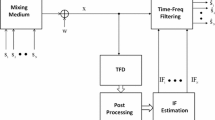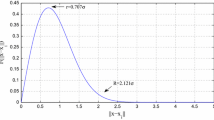Abstract
Conventional decorrelation techniques that resolve all signals simultaneously are not efficient in mixture scenarios of non-coherent and coherent signals. In newer methods for one-dimensional arrays, non-coherent signals and coherent groups are resolved separately. However, employing an unreliable and non-adaptive threshold is the most significant disadvantage of these methods. On the other hand, they cannot be implemented for two-dimensional arrays. To deal with these issues, the signals separation using k-medoids clustering (SSKMC) algorithm was presented. Although the SSKMC algorithm does not have any of the shortcomings mentioned above, it relies on a basic limiting assumption that the sources should be equi-power. Therefore, the practical application of the SSKMC algorithm is facing a serious problem. In this paper, the SSKMC algorithm is extended so that it can be used even if the sources’ powers are not the same. First, the two-dimensional array is divided into several parallel linear sub-arrays. Then, by defining a components separation matrix, and employing its eigenvalues, the non-coherent and coherent components are identified. The effectiveness of the proposed solution is proven by mathematical facts. Simulation results verify the proofs and the benefit of the proposed solution.












Similar content being viewed by others
References
H. Akaike, A new look at the statistical model identification. IEEE Trans. Autom. Control 19(6), 716–723 (1974)
E. Fishler, M. Grosmann, H. Messer, Detection of signals by information theoretic criteria: general asymptotic performance analysis. IEEE Trans. Signal Process. 50(5), 1027–1036 (2002)
O.L. Frost, An algorithm for linearly constrained adaptive array processing. Proc. IEEE 60(8), 926–935 (1972)
X. Fu, R. Cao, F. Wen, A de-noising 2-D-DOA estimation method for uniform rectangle array. IEEE Commun. Lett. 22(9), 1854–1857 (2018)
L. Gan, X. Luo, Direction-of-arrival estimation for uncorrelated and coherent signals in the presence of multipath propagation. IET Microwaves Antennas Propag. 7(9), 746–753 (2013)
E. Gonen, J.M. Mendel, M.C. Dogan, Applications of cumulants to array processing. IV. Direction finding in coherent signals case. IEEE Trans. Signal Process. 45(9), 2265–2276 (1997)
X. Jin, J. Han, K-medoids clustering, in Encyclopedia of Machine Learning and Data Mining (2017), pp. 697–700
F. Liu, J. Wang, C. Sun, R. Du, Spatial differencing method for DOA estimation under the coexistence of both uncorrelated and coherent signals. IEEE Trans. Antennas Propag. 60(4), 2052–2062 (2012)
T. Lu, M. Zhang, T. Kang, A. Zhang, Joint TOA/DOA estimation using the SAGE algorithm in OFDM systems with virtual carriers, in Journal of Physics: Conference Series, vol. 1 (IOP Publishing, 2019), p. 012057
A.M. Molaei, A. Ramezani-Varkani, M.R. Soheilifar, A pure cumulant-based method with low computational complexity for classification and localization of multiple near and far field sources using a symmetric array. Prog. Electromagn. Res. 96, 123–138 (2019)
A.M. Molaei, B. Zakeri, S.M.H. Andargoli, Passive localization and classification of mixed near-field and far-field sources based on high-order differencing algorithm. Signal Process. 157, 119–130 (2019)
A.M. Molaei, B. Zakeri, S.M.H. Andargoli, Closed-form expression of stochastic CRB for mixed near-field and far-field sources in multipath propagation environments. IEEE Commun. Lett. 23(4), 640–643 (2019)
A.M. Molaei, B. Zakeri, S.M.H. Andargoli, Components separation algorithm for localization and classification of mixed near-field and far-field sources in multipath propagation. IEEE Trans. Signal Process. 68, 404–419 (2020)
A.M. Molaei, B. Zakeri, S.M.H. Andargoli, Two-dimensional DOA estimation for multi-path environments by accurate separation of signals using k-medoids clustering. IET Commun. 13(9), 1141–1147 (2019)
A.M. Molaei, M. Hoseinzade, High-performance 2D DOA estimation and 3D localization for mixed near/far-field sources using fourth-order spatiotemporal algorithm. Digit. Signal Proc. 100, 102696 (2020)
A.M. Molaei, M. Hoseinzade, Derivation of multidimensional stochastic Cramer-Rao bound for mixture of noncoherent and coherent near/far field signals. Trans. Emerg. Telecommun. Technol. 31(6), e3971 (2020)
A.M. Molaei, B. Zakeri, S.M.H. Andargoli, High-performance localization of mixed fourth-order stationary sources based on a spatial/temporal full ESPRIT-like method. Signal Process. 171, 107468 (2020)
P. Palanisamy, N. Kalyanasundaram, P. Swetha, Two-dimensional DOA estimation of coherent signals using acoustic vector sensor array. Signal Process. 92(1), 19–28 (2012)
S.U. Pillai, B.H. Kwon, Forward/backward spatial smoothing techniques for coherent signal identification. IEEE Trans. Acoust. Speech Signal Process. 37(1), 8–15 (1989)
S. Ren, X. Ma, S. Yan, C. Hao, 2-D unitary ESPRIT-like direction-of-arrival (DOA) estimation for coherent signals with a uniform rectangular array. Sensors 13(4), 4272–4288 (2013)
T.-J. Shan, M. Wax, T. Kailath, On spatial smoothing for direction-of-arrival estimation of coherent signals. IEEE Trans. Acoust. Speech Signal Process. 33(4), 806–811 (1985)
H. Shi, W. Leng, A. Wang, T. Guo, DOA estimation for mixed uncorrelated and coherent sources in multipath environment. Int. J. Antennas Propag. 2015, 636545 (2015). https://doi.org/10.1155/2015/636545
G. Sreekumar, L. Mary, A. Unnikrishnan, Beam-forming of broadband QFM signals using generalized time–frequency transform. Int. J. Electron. 107, 542–560 (2019)
H. Tao, J. Xin, J. Wang, N. Zheng, A. Sano, Two-dimensional direction estimation for a mixture of noncoherent and coherent signals. IEEE Trans. Signal Process. 63(2), 318–333 (2014)
N. Tayem, Estimation 2D DOA of coherent signals using a new antenna array configuration, in MILCOM 2012-2012 IEEE Military Communications Conference (IEEE, 2012), pp. 1–5
Y. Wang, M. Trinkle, Coherent signals DOA estimation in the presence of complex noise, in International Global Navigation Satellite Systems Society (IGNSS) Symposium 2013, Outrigger Gold Coast, Australia, 16–18 July (2013)
X. Wenmeng, P. José, M. Sylvie, Performance analysis of distributed source parameter estimator (DSPE) in the presence of modeling errors due to the spatial distributions of sources. Signal Process. 143, 146–151 (2018)
X. Xu, Z. Ye, Y. Zhang, DOA estimation for mixed signals in the presence of mutual coupling. IEEE Trans. Signal Process. 57(9), 3523–3532 (2009)
Z.-F. Ye, Y.-F. Zhang, C. Liu, Direction-of-arrival estimation for uncorrelated and coherent signals with fewer sensors. IET Microwaves Antennas Propag. 3(3), 473–482 (2009)
N. Yuen, B. Friedlander, DOA estimation in multipath: an approach using fourth-order cumulants. IEEE Trans. Signal Process. 45(5), 1253–1263 (1997)
Z. Zheng, W.-Q. Wang, H. Meng, H.C. So, H. Zhang, Efficient beamspace-based algorithm for two-dimensional DOA estimation of incoherently distributed sources in massive MIMO systems. IEEE Trans. Veh. Technol. 67(12), 11776–11789 (2018)
Z. Zheng, Y. Yang, W.-Q. Wang, S. Zhang, Two-dimensional direction estimation of multiple signals using two parallel sparse linear arrays. Signal Process. 143, 112–121 (2018)
Z. Zheng, S. Mu, Two-dimensional DOA estimation using two parallel nested arrays. IEEE Commun. Lett. 24(3), 568–571 (2020). https://doi.org/10.1109/LCOMM.2019.2958903
Z. Zheng, Y. Huang, W.-Q. Wang, H.C. So, Direction-of-arrival estimation of coherent signals via coprime array interpolation. IEEE Signal Process. Lett. 27, 585–589 (2020)
Author information
Authors and Affiliations
Corresponding author
Additional information
Publisher's Note
Springer Nature remains neutral with regard to jurisdictional claims in published maps and institutional affiliations.
Appendix: Proof of Inequality \( \left| {\iota_{{K_{n} + g}} } \right| < 1 \)
Appendix: Proof of Inequality \( \left| {\iota_{{K_{n} + g}} } \right| < 1 \)
Given Eq. (24), the triangular inequality and the fact that \( \left| {e^{{j\frac{2\pi }{\lambda }d_{y} \cos \theta_{{\left( {K_{n} + g} \right)i}} \sin \varphi_{{\left( {K_{n} + g} \right)i}} }} } \right| = 1 \), we have
Note that since, according to [A4], for \( i,\,i^{\prime} = 1,\,\ldots,\,p_{g} \) and \( i \ne i^{\prime} \), we have \( \cos \theta_{{\left( {K_{n} + g} \right)i}} \sin \varphi_{{\left( {K_{n} + g} \right)i}} \ne \cos \theta_{{\left( {K_{n} + g} \right)i^{\prime} }} \sin \varphi_{{\left( {K_{n} + g} \right)i^{\prime} }} \), so the equality does not hold in triangular inequality. On the other hand, since \( {\varvec{\upbeta}}_{g} = {\varvec{\upalpha}}_{g}^{\dag } \), \( \beta_{gp} \) s can be calculated in terms of the FCs as follows:
So, \( \beta_{gp} \) can be written as
Consequently, according to Eqs. (25) and (27), we can write
So, the inequality is proved.
Rights and permissions
About this article
Cite this article
Molaei, A.M., Zakeri, B. & Hosseini Andargoli, S.M. Efficient Clustering of Non-coherent and Coherent Components Regardless of Sources’ Powers for 2D DOA Estimation. Circuits Syst Signal Process 40, 756–771 (2021). https://doi.org/10.1007/s00034-020-01494-8
Received:
Revised:
Accepted:
Published:
Issue Date:
DOI: https://doi.org/10.1007/s00034-020-01494-8




